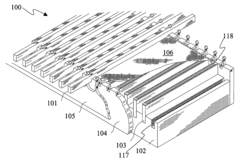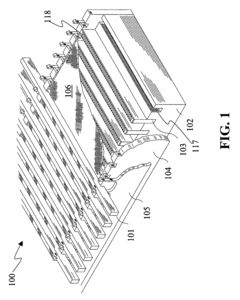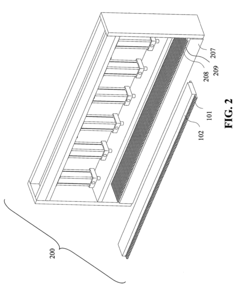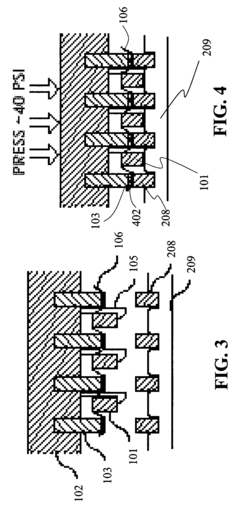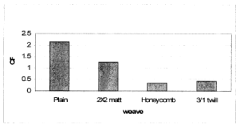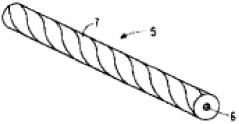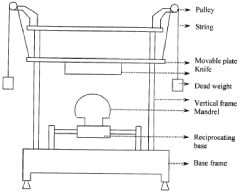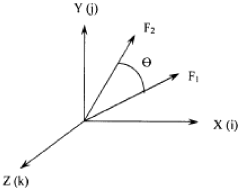How to Revolutionize Textile Durability with Kevlar?
JUL 10, 20259 MIN READ
Generate Your Research Report Instantly with AI Agent
Patsnap Eureka helps you evaluate technical feasibility & market potential.
Kevlar Textile Evolution
Kevlar, a revolutionary synthetic fiber developed by DuPont in the 1960s, has undergone significant evolution in its application to textiles. Initially designed for use in tires, Kevlar's exceptional strength-to-weight ratio and heat-resistant properties quickly led to its adoption in a wide range of textile applications. The evolution of Kevlar in textiles can be traced through several key stages, each marked by technological advancements and expanding use cases.
In the 1970s, Kevlar's potential in protective gear was first realized, with its introduction into bulletproof vests. This marked a pivotal moment in textile durability, as Kevlar offered unprecedented levels of protection while maintaining flexibility and relative comfort. The success in this field spurred further research into Kevlar's textile applications, leading to its incorporation into firefighter gear, military equipment, and high-performance sportswear.
The 1980s and 1990s saw a broadening of Kevlar's use in consumer products. Manufacturers began incorporating Kevlar into everyday items such as work gloves, cut-resistant clothing, and even consumer electronics cases. This period also witnessed significant improvements in Kevlar's manufacturing processes, resulting in fibers with enhanced properties and more consistent quality.
As the new millennium approached, researchers focused on developing hybrid fabrics that combined Kevlar with other materials to create textiles with tailored properties. These innovations led to the creation of ultra-lightweight, highly durable fabrics used in aerospace applications, extreme sports equipment, and advanced military gear. The development of Kevlar-based composites also opened up new possibilities in structural textiles for architectural and industrial uses.
Recent years have seen a shift towards sustainability and eco-friendly production methods in the Kevlar textile industry. Efforts to reduce the environmental impact of Kevlar production and improve its recyclability have become key focus areas. Additionally, nanotechnology has played a crucial role in enhancing Kevlar's properties at the molecular level, leading to even stronger and more versatile textiles.
The ongoing evolution of Kevlar in textiles continues to push the boundaries of material science. Current research is exploring the integration of smart technologies with Kevlar fabrics, potentially leading to textiles with embedded sensors, adaptive properties, and enhanced functionality. These advancements promise to revolutionize not only the durability of textiles but also their interactive and responsive capabilities, opening up new frontiers in wearable technology and protective gear.
In the 1970s, Kevlar's potential in protective gear was first realized, with its introduction into bulletproof vests. This marked a pivotal moment in textile durability, as Kevlar offered unprecedented levels of protection while maintaining flexibility and relative comfort. The success in this field spurred further research into Kevlar's textile applications, leading to its incorporation into firefighter gear, military equipment, and high-performance sportswear.
The 1980s and 1990s saw a broadening of Kevlar's use in consumer products. Manufacturers began incorporating Kevlar into everyday items such as work gloves, cut-resistant clothing, and even consumer electronics cases. This period also witnessed significant improvements in Kevlar's manufacturing processes, resulting in fibers with enhanced properties and more consistent quality.
As the new millennium approached, researchers focused on developing hybrid fabrics that combined Kevlar with other materials to create textiles with tailored properties. These innovations led to the creation of ultra-lightweight, highly durable fabrics used in aerospace applications, extreme sports equipment, and advanced military gear. The development of Kevlar-based composites also opened up new possibilities in structural textiles for architectural and industrial uses.
Recent years have seen a shift towards sustainability and eco-friendly production methods in the Kevlar textile industry. Efforts to reduce the environmental impact of Kevlar production and improve its recyclability have become key focus areas. Additionally, nanotechnology has played a crucial role in enhancing Kevlar's properties at the molecular level, leading to even stronger and more versatile textiles.
The ongoing evolution of Kevlar in textiles continues to push the boundaries of material science. Current research is exploring the integration of smart technologies with Kevlar fabrics, potentially leading to textiles with embedded sensors, adaptive properties, and enhanced functionality. These advancements promise to revolutionize not only the durability of textiles but also their interactive and responsive capabilities, opening up new frontiers in wearable technology and protective gear.
Market Demand Analysis
The market demand for Kevlar-enhanced textiles has been steadily growing, driven by the increasing need for high-performance materials across various industries. Kevlar, known for its exceptional strength-to-weight ratio and heat resistance, has found applications far beyond its original use in bulletproof vests. The global aramid fiber market, of which Kevlar is a significant part, is experiencing robust growth, with projections indicating continued expansion in the coming years.
In the automotive sector, there is a rising demand for lightweight yet durable materials to improve fuel efficiency and safety. Kevlar-reinforced composites are increasingly being used in automotive components, such as tires, hoses, and body panels. This trend is expected to accelerate as automakers strive to meet stringent fuel economy standards while maintaining vehicle safety and performance.
The aerospace industry represents another significant market for Kevlar-enhanced textiles. The material's high strength and low weight make it ideal for aircraft components, including fuselage panels, wing structures, and interior furnishings. As the aerospace industry continues to focus on fuel efficiency and cost reduction, the demand for Kevlar-based materials is likely to increase.
In the personal protective equipment (PPE) sector, Kevlar remains a crucial material for manufacturing cut-resistant gloves, protective clothing, and helmets. The growing emphasis on workplace safety across industries, coupled with stringent regulations, is driving the demand for high-performance protective gear. This trend is particularly evident in sectors such as manufacturing, construction, and oil and gas.
The sports and recreation industry has also recognized the potential of Kevlar-enhanced textiles. From high-performance sportswear to outdoor equipment, manufacturers are incorporating Kevlar to improve durability and reduce weight. This trend is expected to continue as consumers increasingly seek products that offer both performance and longevity.
Environmental concerns and the push for sustainability are influencing market demand as well. Kevlar's durability and potential for recycling align with the growing focus on sustainable materials. Industries are exploring ways to incorporate Kevlar into products that require less frequent replacement, thereby reducing waste and environmental impact.
Despite the positive market outlook, challenges remain. The high cost of Kevlar compared to traditional materials can be a barrier to adoption in some applications. Additionally, the complexity of working with Kevlar in textile manufacturing processes may limit its use in certain sectors. However, ongoing research and development efforts are focused on addressing these challenges, potentially opening up new market opportunities.
As industries continue to seek innovative solutions for improving product performance and durability, the demand for Kevlar-enhanced textiles is expected to grow. The material's unique properties position it well to meet the evolving needs of various sectors, from transportation to personal protection and beyond.
In the automotive sector, there is a rising demand for lightweight yet durable materials to improve fuel efficiency and safety. Kevlar-reinforced composites are increasingly being used in automotive components, such as tires, hoses, and body panels. This trend is expected to accelerate as automakers strive to meet stringent fuel economy standards while maintaining vehicle safety and performance.
The aerospace industry represents another significant market for Kevlar-enhanced textiles. The material's high strength and low weight make it ideal for aircraft components, including fuselage panels, wing structures, and interior furnishings. As the aerospace industry continues to focus on fuel efficiency and cost reduction, the demand for Kevlar-based materials is likely to increase.
In the personal protective equipment (PPE) sector, Kevlar remains a crucial material for manufacturing cut-resistant gloves, protective clothing, and helmets. The growing emphasis on workplace safety across industries, coupled with stringent regulations, is driving the demand for high-performance protective gear. This trend is particularly evident in sectors such as manufacturing, construction, and oil and gas.
The sports and recreation industry has also recognized the potential of Kevlar-enhanced textiles. From high-performance sportswear to outdoor equipment, manufacturers are incorporating Kevlar to improve durability and reduce weight. This trend is expected to continue as consumers increasingly seek products that offer both performance and longevity.
Environmental concerns and the push for sustainability are influencing market demand as well. Kevlar's durability and potential for recycling align with the growing focus on sustainable materials. Industries are exploring ways to incorporate Kevlar into products that require less frequent replacement, thereby reducing waste and environmental impact.
Despite the positive market outlook, challenges remain. The high cost of Kevlar compared to traditional materials can be a barrier to adoption in some applications. Additionally, the complexity of working with Kevlar in textile manufacturing processes may limit its use in certain sectors. However, ongoing research and development efforts are focused on addressing these challenges, potentially opening up new market opportunities.
As industries continue to seek innovative solutions for improving product performance and durability, the demand for Kevlar-enhanced textiles is expected to grow. The material's unique properties position it well to meet the evolving needs of various sectors, from transportation to personal protection and beyond.
Kevlar Tech Challenges
Despite its remarkable properties, Kevlar faces several technical challenges that hinder its widespread adoption in textile applications. One of the primary obstacles is the high cost of production, which limits its use to specialized industries and high-performance products. The complex manufacturing process, involving the use of concentrated sulfuric acid and high temperatures, contributes significantly to this cost barrier.
Another challenge lies in the difficulty of dyeing and coloring Kevlar fibers. The chemical structure that gives Kevlar its strength also makes it resistant to conventional dyeing methods. This limitation restricts its aesthetic versatility and potential applications in fashion and consumer textiles.
Kevlar's inherent stiffness poses challenges in terms of comfort and flexibility when used in clothing or wearable applications. While its rigidity contributes to its strength, it can result in garments that are less comfortable or adaptable to body movements compared to traditional textiles.
The material's sensitivity to ultraviolet (UV) light presents another significant hurdle. Prolonged exposure to UV radiation can degrade Kevlar's mechanical properties, potentially compromising its durability and performance over time. This vulnerability necessitates additional protective measures or treatments when used in outdoor applications.
Processing and integrating Kevlar into existing textile manufacturing systems also presents technical difficulties. Its high strength and low elongation properties can cause challenges in spinning, weaving, and finishing processes designed for more conventional fibers.
Environmental concerns surrounding Kevlar production and disposal represent another area of challenge. The use of harsh chemicals in its manufacture and the material's resistance to biodegradation raise questions about its long-term environmental impact and sustainability.
Improving Kevlar's moisture absorption capabilities remains an ongoing challenge. While its hydrophobic nature contributes to its strength, it can lead to discomfort in clothing applications and limit its use in moisture-wicking fabrics.
Lastly, enhancing Kevlar's fire resistance without compromising its other properties is an area of active research. Although Kevlar has inherent flame-resistant properties, improving its performance under extreme heat conditions could expand its applications in protective gear and firefighting equipment.
Addressing these technical challenges is crucial for revolutionizing textile durability with Kevlar. Innovations in production methods, surface treatments, and composite technologies are being explored to overcome these limitations and unlock the full potential of Kevlar in a wider range of textile applications.
Another challenge lies in the difficulty of dyeing and coloring Kevlar fibers. The chemical structure that gives Kevlar its strength also makes it resistant to conventional dyeing methods. This limitation restricts its aesthetic versatility and potential applications in fashion and consumer textiles.
Kevlar's inherent stiffness poses challenges in terms of comfort and flexibility when used in clothing or wearable applications. While its rigidity contributes to its strength, it can result in garments that are less comfortable or adaptable to body movements compared to traditional textiles.
The material's sensitivity to ultraviolet (UV) light presents another significant hurdle. Prolonged exposure to UV radiation can degrade Kevlar's mechanical properties, potentially compromising its durability and performance over time. This vulnerability necessitates additional protective measures or treatments when used in outdoor applications.
Processing and integrating Kevlar into existing textile manufacturing systems also presents technical difficulties. Its high strength and low elongation properties can cause challenges in spinning, weaving, and finishing processes designed for more conventional fibers.
Environmental concerns surrounding Kevlar production and disposal represent another area of challenge. The use of harsh chemicals in its manufacture and the material's resistance to biodegradation raise questions about its long-term environmental impact and sustainability.
Improving Kevlar's moisture absorption capabilities remains an ongoing challenge. While its hydrophobic nature contributes to its strength, it can lead to discomfort in clothing applications and limit its use in moisture-wicking fabrics.
Lastly, enhancing Kevlar's fire resistance without compromising its other properties is an area of active research. Although Kevlar has inherent flame-resistant properties, improving its performance under extreme heat conditions could expand its applications in protective gear and firefighting equipment.
Addressing these technical challenges is crucial for revolutionizing textile durability with Kevlar. Innovations in production methods, surface treatments, and composite technologies are being explored to overcome these limitations and unlock the full potential of Kevlar in a wider range of textile applications.
Current Kevlar Solutions
01 Kevlar reinforcement in protective gear
Kevlar is widely used in protective equipment due to its high durability and strength. It is incorporated into various types of gear such as helmets, body armor, and gloves to enhance their protective capabilities and longevity. The integration of Kevlar fibers significantly improves the overall durability and impact resistance of these protective items.- Kevlar reinforcement in protective gear: Kevlar is widely used in protective equipment due to its high durability and strength. It is incorporated into various types of gear such as helmets, vests, and gloves to enhance their protective capabilities against impacts, cuts, and abrasions. The integration of Kevlar fibers significantly improves the overall durability and longevity of these protective items.
- Kevlar-enhanced composite materials: Kevlar is utilized in the development of advanced composite materials to improve their durability and performance. These composites combine Kevlar fibers with other materials like resins or polymers to create lightweight yet highly durable structures. Such composites find applications in aerospace, automotive, and marine industries where high strength-to-weight ratio and longevity are crucial.
- Kevlar treatment for enhanced durability: Various treatments and processes are applied to Kevlar fibers to further enhance their durability. These may include chemical treatments, coatings, or specialized manufacturing techniques that improve the fiber's resistance to environmental factors, UV radiation, and wear. Such treatments can significantly extend the lifespan and maintain the performance of Kevlar-based products in challenging conditions.
- Kevlar in high-performance textiles: Kevlar is incorporated into high-performance textiles to create durable fabrics for extreme conditions. These textiles are designed to withstand harsh environments, high temperatures, and intense physical stress. Applications include firefighting gear, military uniforms, and industrial protective clothing, where the durability of Kevlar significantly enhances the longevity and protective qualities of the garments.
- Kevlar-based structural reinforcement: Kevlar fibers are used for structural reinforcement in various applications to improve durability and load-bearing capacity. This includes reinforcing concrete structures, strengthening building materials, and enhancing the durability of infrastructure components. The high tensile strength and durability of Kevlar make it an excellent choice for extending the lifespan and improving the performance of structures subject to significant stress and environmental factors.
02 Kevlar-enhanced composite materials
Kevlar is utilized in the development of advanced composite materials to improve their durability and performance. These composites combine Kevlar fibers with other materials like resins or polymers to create structures with enhanced strength, lightweight properties, and resistance to wear and tear. Such composites find applications in aerospace, automotive, and industrial sectors.Expand Specific Solutions03 Kevlar in high-performance textiles
Kevlar is incorporated into high-performance textiles to enhance their durability and protective qualities. These textiles are used in the production of cut-resistant clothing, fire-resistant garments, and other specialized apparel. The addition of Kevlar fibers significantly improves the fabric's resistance to abrasion, cuts, and heat, extending the lifespan of the textile products.Expand Specific Solutions04 Kevlar-reinforced structural components
Kevlar is used to reinforce various structural components to enhance their durability and strength. This includes applications in construction materials, automotive parts, and industrial equipment. The incorporation of Kevlar fibers helps to improve the overall lifespan and performance of these components, particularly in high-stress or high-wear environments.Expand Specific Solutions05 Surface treatments for Kevlar durability enhancement
Various surface treatments and coatings are applied to Kevlar fibers and fabrics to further enhance their durability. These treatments can improve resistance to UV radiation, chemicals, and moisture, thereby extending the material's lifespan and maintaining its performance characteristics over time. Such enhancements are particularly important in outdoor and harsh environmental applications.Expand Specific Solutions
Key Industry Players
The development of Kevlar-enhanced textile durability is in a mature phase, with significant market potential across various industries. The global market for high-performance fibers, including Kevlar, is projected to reach substantial growth in the coming years. Technologically, the field is well-established, with ongoing research focused on improving properties and expanding applications. Key players like DuPont (Kevlar's inventor) lead the industry, while academic institutions such as Massachusetts Institute of Technology and Indian Institutes of Technology contribute to advancements. Companies like Northrop Grumman Systems Corp. and Concordia Textiles NV are exploring innovative applications in aerospace and specialized textiles, indicating a competitive and diverse landscape in Kevlar-enhanced textile development.
Harbin Institute of Technology
Technical Solution: HIT has focused on enhancing Kevlar's durability through nanocomposite technology. Their research involves incorporating various nanoparticles, such as silica and titanium dioxide, into Kevlar fibers. This approach has resulted in Kevlar nanocomposites with improved tensile strength, modulus, and thermal stability. One notable achievement is the development of a Kevlar/graphene oxide nanocomposite that exhibits a 20% increase in tensile strength and a 15% improvement in Young's modulus compared to standard Kevlar[7]. HIT researchers have also explored electrospinning techniques to create Kevlar nanofibers with enhanced surface area and mechanical properties, opening up new possibilities for applications in filtration and energy storage[8].
Strengths: Expertise in nanocomposite technology, potential for multifunctional Kevlar materials. Weaknesses: Possible challenges in large-scale production and cost-effectiveness of nanocomposite materials.
United States Army
Technical Solution: The U.S. Army has been at the forefront of Kevlar innovation, particularly in developing advanced body armor systems. Their research focuses on integrating Kevlar with other materials to create multi-layered protective gear. One notable advancement is the development of liquid armor, which combines Kevlar fabric with a shear thickening fluid (STF). This composite material remains flexible under normal conditions but instantly hardens upon impact, providing superior protection against ballistic threats[2]. The Army has also explored nanotechnology to enhance Kevlar's properties, including the incorporation of carbon nanotubes to improve strength-to-weight ratios and energy dissipation capabilities[4].
Strengths: Cutting-edge research in protective gear, potential for dual-use technologies. Weaknesses: High development costs, potential limitations in civilian applications due to military focus.
Kevlar Core Innovations
Honeycomb core composite article and method and apparatus for making same
PatentInactiveUS7083753B2
Innovation
- A process involving the use of thermo-set polymer impregnated fabrics, such as KEVLAR®, where the fabric is aligned and held by bolster plates with heating elements and pins to concentrate pressure and heat, allowing for node-by-node curing and co-curing of plies to form a honeycomb core with controlled orientation for optimal mechanical properties.
Design and development of an instrument to measure cut resistance of fabrics
PatentInactiveIN276DEL2008A
Innovation
- Development of an instrument to measure cut resistance by determining the load required and distance traveled to make a cut in fabrics, along with a model to analyze cutting forces and distance, which considers fabric construction, material parameters, and process parameters to optimize cut-resistant fabric design.
Environmental Impact
The incorporation of Kevlar into textile manufacturing processes presents both opportunities and challenges from an environmental perspective. While Kevlar's exceptional durability can contribute to reduced waste and longer-lasting products, its production and disposal require careful consideration.
Kevlar's production process involves the use of strong acids and organic solvents, which can have significant environmental impacts if not properly managed. The energy-intensive manufacturing process also contributes to greenhouse gas emissions. However, advancements in production techniques have led to more efficient processes, reducing the overall environmental footprint of Kevlar production.
One of the key environmental benefits of using Kevlar in textiles is its potential to extend product lifespans. By enhancing the durability of fabrics, Kevlar can reduce the need for frequent replacements, thereby decreasing overall resource consumption and waste generation. This aligns with the principles of circular economy and sustainable product design.
The recyclability of Kevlar-enhanced textiles is an area of ongoing research and development. While pure Kevlar fibers can be recycled, the process becomes more complex when Kevlar is blended with other materials. Innovations in recycling technologies are crucial to maximizing the environmental benefits of Kevlar-enhanced textiles throughout their lifecycle.
In terms of biodegradability, Kevlar presents challenges. As a synthetic polymer, it does not naturally decompose in the environment. This persistence can lead to long-term environmental impacts if Kevlar-enhanced textiles are not properly disposed of or recycled. Research into biodegradable alternatives or end-of-life solutions for Kevlar-enhanced products is essential for mitigating these concerns.
The use of Kevlar in protective clothing and equipment can indirectly contribute to environmental conservation. By providing superior protection in hazardous environments, Kevlar-enhanced gear can support safer and more efficient operations in industries such as firefighting and environmental cleanup, potentially reducing the environmental impact of these activities.
Water usage and pollution are additional factors to consider. While Kevlar production requires water, advancements in manufacturing processes have led to more efficient water use and improved wastewater treatment methods. Implementing closed-loop systems and water recycling technologies can further reduce the water-related environmental impact of Kevlar production.
As the textile industry moves towards more sustainable practices, the environmental impact of Kevlar must be continuously assessed and improved. This includes exploring bio-based alternatives, enhancing recycling capabilities, and optimizing production processes to minimize resource consumption and emissions. By addressing these challenges, the revolutionary potential of Kevlar in textile durability can be realized while minimizing its environmental footprint.
Kevlar's production process involves the use of strong acids and organic solvents, which can have significant environmental impacts if not properly managed. The energy-intensive manufacturing process also contributes to greenhouse gas emissions. However, advancements in production techniques have led to more efficient processes, reducing the overall environmental footprint of Kevlar production.
One of the key environmental benefits of using Kevlar in textiles is its potential to extend product lifespans. By enhancing the durability of fabrics, Kevlar can reduce the need for frequent replacements, thereby decreasing overall resource consumption and waste generation. This aligns with the principles of circular economy and sustainable product design.
The recyclability of Kevlar-enhanced textiles is an area of ongoing research and development. While pure Kevlar fibers can be recycled, the process becomes more complex when Kevlar is blended with other materials. Innovations in recycling technologies are crucial to maximizing the environmental benefits of Kevlar-enhanced textiles throughout their lifecycle.
In terms of biodegradability, Kevlar presents challenges. As a synthetic polymer, it does not naturally decompose in the environment. This persistence can lead to long-term environmental impacts if Kevlar-enhanced textiles are not properly disposed of or recycled. Research into biodegradable alternatives or end-of-life solutions for Kevlar-enhanced products is essential for mitigating these concerns.
The use of Kevlar in protective clothing and equipment can indirectly contribute to environmental conservation. By providing superior protection in hazardous environments, Kevlar-enhanced gear can support safer and more efficient operations in industries such as firefighting and environmental cleanup, potentially reducing the environmental impact of these activities.
Water usage and pollution are additional factors to consider. While Kevlar production requires water, advancements in manufacturing processes have led to more efficient water use and improved wastewater treatment methods. Implementing closed-loop systems and water recycling technologies can further reduce the water-related environmental impact of Kevlar production.
As the textile industry moves towards more sustainable practices, the environmental impact of Kevlar must be continuously assessed and improved. This includes exploring bio-based alternatives, enhancing recycling capabilities, and optimizing production processes to minimize resource consumption and emissions. By addressing these challenges, the revolutionary potential of Kevlar in textile durability can be realized while minimizing its environmental footprint.
Safety Regulations
The integration of Kevlar into textile manufacturing processes necessitates a comprehensive understanding and adherence to safety regulations. These regulations are crucial for ensuring the protection of workers, consumers, and the environment throughout the production, distribution, and use of Kevlar-enhanced textiles.
In the manufacturing phase, strict guidelines are in place to manage the handling of Kevlar fibers. Workers must be equipped with appropriate personal protective equipment (PPE), including respiratory protection, as fine Kevlar particles can pose inhalation risks. Ventilation systems in production facilities must meet specific standards to minimize airborne fiber concentrations. Additionally, proper waste management protocols are essential to prevent environmental contamination.
For consumer products incorporating Kevlar, safety regulations focus on ensuring the material's integrity and performance under various conditions. This includes rigorous testing for flame resistance, as Kevlar is often used in fire-resistant clothing. Standards such as NFPA 1971 for firefighting gear and ASTM F1506 for electrical workers' apparel dictate the minimum performance requirements for Kevlar-enhanced protective clothing.
In the automotive and aerospace industries, where Kevlar is utilized for its high strength-to-weight ratio, safety regulations are particularly stringent. These sectors require compliance with standards like FMVSS (Federal Motor Vehicle Safety Standards) and FAA (Federal Aviation Administration) regulations, which specify the performance criteria for materials used in vehicle and aircraft construction.
The use of Kevlar in personal protective equipment, such as bulletproof vests, is governed by NIJ (National Institute of Justice) standards. These regulations define the levels of protection and testing procedures to ensure the effectiveness of Kevlar-based armor against various threats.
Environmental regulations also play a significant role in the Kevlar industry. Manufacturers must adhere to guidelines set by environmental protection agencies regarding the disposal of Kevlar waste and the management of chemical processes involved in its production. This includes compliance with regulations such as REACH (Registration, Evaluation, Authorization and Restriction of Chemicals) in the European Union.
As Kevlar technology continues to evolve, safety regulations are likely to adapt. Ongoing research into the long-term effects of Kevlar exposure and its environmental impact may lead to the development of new safety protocols. Manufacturers and researchers working on revolutionizing textile durability with Kevlar must stay informed about these evolving regulations to ensure compliance and maintain the highest safety standards in their innovative products.
In the manufacturing phase, strict guidelines are in place to manage the handling of Kevlar fibers. Workers must be equipped with appropriate personal protective equipment (PPE), including respiratory protection, as fine Kevlar particles can pose inhalation risks. Ventilation systems in production facilities must meet specific standards to minimize airborne fiber concentrations. Additionally, proper waste management protocols are essential to prevent environmental contamination.
For consumer products incorporating Kevlar, safety regulations focus on ensuring the material's integrity and performance under various conditions. This includes rigorous testing for flame resistance, as Kevlar is often used in fire-resistant clothing. Standards such as NFPA 1971 for firefighting gear and ASTM F1506 for electrical workers' apparel dictate the minimum performance requirements for Kevlar-enhanced protective clothing.
In the automotive and aerospace industries, where Kevlar is utilized for its high strength-to-weight ratio, safety regulations are particularly stringent. These sectors require compliance with standards like FMVSS (Federal Motor Vehicle Safety Standards) and FAA (Federal Aviation Administration) regulations, which specify the performance criteria for materials used in vehicle and aircraft construction.
The use of Kevlar in personal protective equipment, such as bulletproof vests, is governed by NIJ (National Institute of Justice) standards. These regulations define the levels of protection and testing procedures to ensure the effectiveness of Kevlar-based armor against various threats.
Environmental regulations also play a significant role in the Kevlar industry. Manufacturers must adhere to guidelines set by environmental protection agencies regarding the disposal of Kevlar waste and the management of chemical processes involved in its production. This includes compliance with regulations such as REACH (Registration, Evaluation, Authorization and Restriction of Chemicals) in the European Union.
As Kevlar technology continues to evolve, safety regulations are likely to adapt. Ongoing research into the long-term effects of Kevlar exposure and its environmental impact may lead to the development of new safety protocols. Manufacturers and researchers working on revolutionizing textile durability with Kevlar must stay informed about these evolving regulations to ensure compliance and maintain the highest safety standards in their innovative products.
Unlock deeper insights with Patsnap Eureka Quick Research — get a full tech report to explore trends and direct your research. Try now!
Generate Your Research Report Instantly with AI Agent
Supercharge your innovation with Patsnap Eureka AI Agent Platform!
